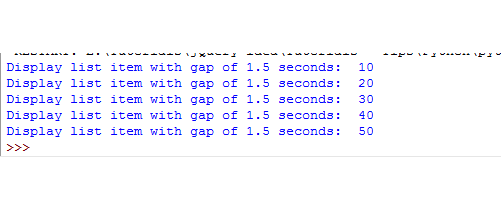
If the input time is in milliseconds, as you mentioned, it must be converted to seconds before passing it to the sleep() function, as one second is equivalent to 1000 milliseconds. It also provides a sleep() function which can be used to pause the execution of a program for a specified amount of time, usually in seconds. # This text is printed after 800 milliseconds.Īlternatively, the time module in Python provides various functions and classes to work with time and dates, including the time() function which returns the current time in seconds. Print("This text is printed after 800 milliseconds.") # After 0.08 seconds, Sparkbyexamples will be printed

Print("After 0.08 seconds, Sparkbyexamples will be printed") The Timer function takes two arguments: the first is the time delay in seconds, and the second is the function that should be executed. Uses the timer function from the Python threading module to schedule a function to be executed after sleeping for milliseconds.

# Sleep for 0.3 seconds, equivalent to 300 millisecondsĢ. Note that the above sleep function takes delay time in seconds, so to pass 300 milliseconds we need to divide it by 1000.
#PYTHON SLEEP CODE#
The code waits for 0.3 seconds (300 milliseconds) before printing “300 milliseconds passed”.

Since 1 second is equal to 1000 milliseconds, we are dividing the milliseconds by 1000 to get the fraction of the second. To sleep the execution for 300 milliseconds (0.3 seconds) in Python, you can either divide this number by 1000 and pass the fraction of the second or use the expression directly to the time.sleep() function. Here, the code first prints “Sleep time: 3 seconds” and then waits for 3 seconds before printing “Woke up after 3 seconds”. Print('Woke up after: ', str(3), 'seconds') First, let’s see how this function works with seconds, and in the next example, I will show it with milliseconds. To sleep the execution for a specified number of milliseconds in Python, you need to divide the milliseconds by 1000 to get the faction of the second and pass it as an argument to the sleep() method. ‘time’ is either a unix timestamp in seconds (i.e.Linux Sleep Command - (How to) delay for a specified amount of time 1. Pause your program until a specific end time. Pause until a unix time, with millisecond precision: import pause
#PYTHON SLEEP INSTALL#
Or, without downloading, install with pip: sudo pip install pause Examples: Installĭownload the source code and run the following command: sudo python. After this time, it recomputes the new pause duration, repeating this process until the desired time is reached. This module computes the pause duration between now and the future date, and then sleeps for half of this duration. The precision should be within 0.001 of a second, however, this will depend on how precise your system sleep is and other performance factors. When the current time is equal or greater than the end time, the method will allow your program can resume. Then a loop will be started that will continually check the current time against the end time. When you create a pause, it will determine what the end time of that pause should be.

On the other hand, with conds(3600), if your computer goes into standby mode for several hours, the program will continue immediately after the machine wakes back up since the minimum amount of time has passed since the pause was started. If your computer goes into standby mode during minute one, and wakes up several hours later, your program will continue to be paused for 59 minutes. This works similarly to time.sleep, but uses your computers timestamp to track time, versus a counter.įor example, traditionally using time.sleep(3600), will pause the program for 60 minutes. Suspend the execution of your program for a given amount of time.


 0 kommentar(er)
0 kommentar(er)
